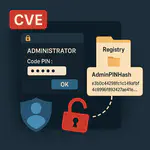All posts for: TSPlus
Tags
- .NET MAUI 9
- Android
- Attack Automation
- Brute-force
- Burp
- Bypassing Security
- Campaign
- CDeX
- Cloud
- Container security
- CSRF Token
- CTF
- CVE-2024-2463
- CVE-2024-2464
- CVE-2024-2465
- CVE-2025-5922
- DevOps tools
- DFIR
- Dictionary Attack
- Docker
- Encrypted Requests
- Flask
- Forensics
- Hard
- Hostnames
- HTB
- Huntress
- Hydra
- Insane
- Ligolo-ng
- Linux containers
- LOLBin
- Malware
- Malware Analysis
- Medium
- Metasploit
- MSBuild
- Nessus plugin
- Network pivoting
- Penetration Testing
- Pentesting
- Phishing
- Pivoting tools
- Python
- Red Team
- Remote Access
- Reverse Engineering
- Reverse engineering .NET MAUI
- RSA keys
- Scan report
- Sherlock
- Signed Requests
- Social Engineering
- systemd-nspawn
- Threat Intelligence
- ThreatCheck
- Tips&Tricks
- TSPlus
- Vulnerability
- Vulnerability scanning
- Web
- Web scanning
- Windows 11
- Windows Defender
- Xamarin
- ZAP
